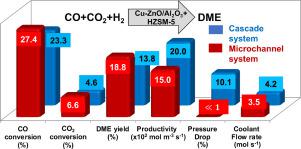Chemical Engineering and Processing: Process Intensification ( IF 3.8 ) Pub Date : 2021-07-12 , DOI: 10.1016/j.cep.2021.108538 H. Hasan Koybasi 1 , Ceren Hatipoglu 1 , Ahmet K. Avci 1

|
Comparison is drawn among two intensified reactor systems proposed for meeting precise temperature regulation requirement of the direct conversion of syngas to dimethyl ether (DME). In the first (microchannel) system, reaction channels washcoated with physical mixture of catalysts for methanol synthesis (Cu–ZnO/Al2O3) and dehydration (HZSM–5) are accompanied by cooling channels. Decoupled catalytic reaction and cooling functions are conducted in interconnected adiabatic packed–bed reactors and microchannel heat exchangers, respectively, in the second (cascade) system. Both systems are compared under identical inlet conditions, catalyst types and residence times via computational modeling coupled with realistic constraints. Upon syngas (CO2/COx (COx:CO+CO2)=0.2 and H2/COx=2.0) feeding at 493 K, 50 bar and residence time of 1.05 kgcat.s/mol, conversions of CO and CO2, and DME yield are found as 27.4, 6.6 and 18.8%, respectively, for the microchannel, and 23.3, 4.6 and 13.8%, respectively, for the cascade system. At a pilot–scale gasifier syngas throughput of 0.77 mol/s, volumes of the microchannel and cascade systems, the latter being composed of five reactors and four heat exchangers, are computed as 104.5 and 56.2 liters, respectively. Productivity (molDME/m3.s) of the microchannel system (0.15) remains below that of the cascade (0.20), which, however, suffers from notable pressure drop.
中文翻译:

用于将含CO 2的合成气一步转化为二甲醚的强化反应器系统的比较
比较了为满足合成气直接转化为二甲醚 (DME) 的精确温度调节要求而提出的两种强化反应器系统。在第一个(微通道)系统中,反应通道涂有甲醇合成(Cu-ZnO/Al 2 O 3)和脱水(HZSM-5)催化剂的物理混合物,并伴随有冷却通道。分离的催化反应和冷却功能分别在第二个(级联)系统中的互连绝热填充床反应器和微通道换热器中进行。通过结合实际约束的计算建模,在相同的入口条件、催化剂类型和停留时间下比较两个系统。合成气 (CO 2/ CO X(CO X:CO + CO 2)= 0.2和H 2 / CO X = 2.0)在493ķ喂养,1.05公斤的50巴和停留时间猫.S /摩尔,CO和CO的转化率2,和微通道的 DME 产率分别为 27.4、6.6 和 18.8%,级联系统的 DME 产率分别为 23.3、4.6 和 13.8%。在中试规模的气化炉合成气吞吐量为 0.77 mol/s 时,微通道和级联系统(后者由五个反应器和四个热交换器组成)的体积分别计算为 104.5 和 56.2 升。生产率(mol DME /m 3.s) 的微通道系统 (0.15) 仍然低于级联 (0.20),然而,其遭受显着的压降。











































 京公网安备 11010802027423号
京公网安备 11010802027423号